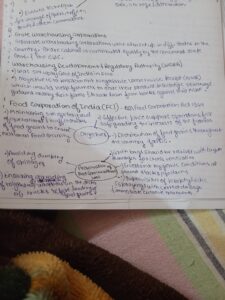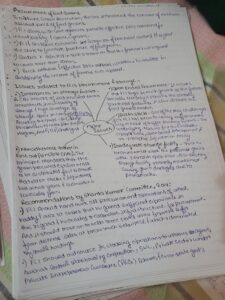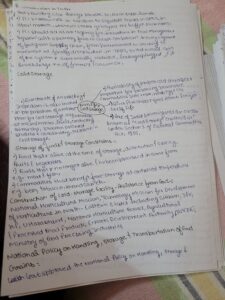Describe the goals and constraints of India’s Public Distribution System (PDS). What actions has the government done to address these restrictions?
The Role of the Public Distribution System (PDS) in India's Food and Agricultural Policies 1. Introduction The Public Distribution System (PDS) is a critical component of India's food and agricultural policies, aimed at ensuring food security for the economically disadvantaged. This system providesRead more
The Role of the Public Distribution System (PDS) in India’s Food and Agricultural Policies
1. Introduction
The Public Distribution System (PDS) is a critical component of India’s food and agricultural policies, aimed at ensuring food security for the economically disadvantaged. This system provides subsidized food grains to the poor and is integral to the government’s broader objectives of promoting sustainable agriculture, improving farmers’ incomes, and ensuring inclusive development. This analysis will explore the role of the PDS within this larger context and evaluate its alignment with the government’s policy goals.
2. Role of the PDS in Food and Agricultural Policies
Ensuring Food Security:
The primary role of the PDS is to ensure food security by distributing essential commodities at subsidized rates to the poor. This is crucial in addressing hunger and malnutrition, especially in vulnerable populations.
Recent Example: During the COVID-19 pandemic, the Indian government expanded the PDS to provide free food grains to an additional 80 crore people under the Pradhan Mantri Garib Kalyan Ann Yojana (PMGKAY), reflecting the system’s role in addressing emergency food security needs.
Stabilizing Prices:
By procuring food grains from farmers and distributing them through the PDS, the government helps stabilize market prices and prevent extreme fluctuations, which can impact both consumers and farmers.
Recent Example: The Minimum Support Price (MSP) mechanism, coupled with PDS operations, has been used to stabilize rice and wheat prices in states like Punjab and Haryana, ensuring price stability in both procurement and consumer markets.
3. Alignment with Government Objectives
Promoting Sustainable Agriculture:
While the PDS itself does not directly address agricultural sustainability, the procurement practices associated with it can influence farming practices. For instance, the MSP encourages farmers to adopt certain crops, which can impact sustainable farming practices.
Recent Example: The introduction of Paddy-to-Millet schemes in states like Jharkhand is part of efforts to encourage sustainable crops. However, the PDS still largely relies on staples like rice and wheat, which can sometimes limit the focus on diverse and sustainable agricultural practices.
Improving Farmers’ Incomes:
The PDS’s procurement system helps ensure a stable income for farmers by guaranteeing the purchase of their produce at predetermined prices. This supports farmers’ incomes and provides them with financial security.
Recent Example: The Pradhan Mantri Annadata Aay Sanrakshan Abhiyan (PM-AASHA) scheme, aimed at enhancing farmers’ income, works in conjunction with the PDS by ensuring better price realization for their produce through MSP and procurement mechanisms.
Ensuring Inclusive Development:
The PDS is designed to be inclusive by targeting subsidized food grains to the economically weaker sections of society. This aligns with broader goals of social equity and poverty alleviation.
Recent Example: The National Food Security Act (NFSA) of 2013 aims to cover 75% of the rural population and 50% of the urban population, thereby ensuring that food security measures reach a large segment of the population, including the poor and vulnerable.
4. Challenges and Areas for Improvement
Limited Focus on Sustainable Agriculture:
The PDS primarily focuses on staple grains, potentially neglecting the promotion of diverse and sustainable agricultural practices. A shift towards supporting a wider range of crops and sustainable practices could enhance alignment with broader agricultural goals.
Recent Example: The government’s focus on cereals has overshadowed the promotion of pulses and oilseeds, which are also critical for nutritional diversity and sustainable agriculture.
Inefficiencies in Distribution:
Issues such as leakages, diversion, and inefficiencies in the PDS distribution network can undermine its effectiveness. These challenges need to be addressed to enhance the overall impact of the PDS on food security and inclusive development.
Recent Example: In Uttar Pradesh, efforts to digitize and streamline the PDS have been implemented to address inefficiencies and improve transparency, but challenges remain in ensuring effective distribution.
Need for Better Integration with Other Policies:
While the PDS plays a crucial role, better integration with agricultural and welfare policies could enhance its effectiveness. Aligning PDS operations with schemes promoting organic farming, crop diversification, and rural development can provide a more comprehensive approach to food and agricultural policy.
Recent Example: The National Mission on Sustainable Agriculture (NMSA) aims to promote sustainable practices, but its integration with PDS could be strengthened to support holistic agricultural development.
5. Conclusion
The Public Distribution System (PDS) is a vital component of India’s food and agricultural policies, contributing significantly to food security, price stabilization, and poverty alleviation. While it supports the government’s objectives of improving farmers’ incomes and ensuring inclusive development, there is room for improvement in aligning PDS operations with sustainable agricultural practices and broader policy goals. Addressing challenges related to inefficiencies and integrating PDS with other agricultural and welfare schemes can enhance its effectiveness and impact on both food security and agricultural development.
See less



Public distribution system (PDS) is a government-sponsored mechanism entrusted with the work of distributing basic food and non-food commodities to the needy sections of the society at subsidised rates. The system is operated jointly by the Central and the state governments. It has following objectiRead more
Public distribution system (PDS) is a government-sponsored mechanism entrusted with the work of distributing basic food and non-food commodities to the needy sections of the society at subsidised rates. The system is operated jointly by the Central and the state governments.
It has following objectives
It is supplemental in nature and is not intended to make available the entire requirement of any of the commodities distributed under it to a household or section of the society. Yet, it acts as a safety net for a large section of the population.
Limitations of PDS In India
Some recent steps taken by government
To improve the PDS further, Wadhwa Committee (2006) and Shanta Kumar Committee (2015) have suggested universalisation of PDS, gradual introduction of cash transfers (DBT) and food coupons. A Universal Basic Income may also be introduced to do away with multiple subsidies existing in India.
See less